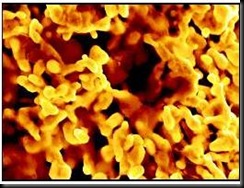The tale of the hen that lay golden eggs is one almost all of us have heard. But Australian scientists have a new tale to tell — that of a ‘golden’ bacteria.
Researchers in kangaroo country have uncovered evidence that a tiny microbe![]() may have the Midas touch of Greek legend — capable of turning dust to gold. A bacteria known as Ralstonia metallidurans may play a key role in forming gold nuggets and grains. A group of scientists led by German-born researcher Frank Reith collected gold grains from two Australian mines more than 3,000 kilometres apart, and discovered that 80% of the grains had the bacteria living on them.
may have the Midas touch of Greek legend — capable of turning dust to gold. A bacteria known as Ralstonia metallidurans may play a key role in forming gold nuggets and grains. A group of scientists led by German-born researcher Frank Reith collected gold grains from two Australian mines more than 3,000 kilometres apart, and discovered that 80% of the grains had the bacteria living on them.
“What we found out suggests that bacteria can accumulate this gold,” Reith told reporters during a telephone interview from his Australian office on Friday. Reith said Ralstonia metallidurans act as microscopic soil scrubbers, soaking up heavy metals in their dissolved form and converting them into less toxic, solid forms.
“Heavy metals are toxic, not only to us but also to micro-organisms, in elevated concentrations,” he said. “It appears to be that the organism can detoxify its immediate environment of this toxic mobile gold and in this way gain a metabolic advantage. That’s why it would be present on these gold grains,” he elucidated.
Many scientists have questioned the possible microbial role in forming gold, maintaining instead that gold grains were either remnants of larger pieces or formed through chemical processes over a period of time.
Reith said his findings provide the strongest evidence yet that bacteria could play a key role in creating solid gold and could bring about a revolution in the entire industry in terms of its economics and revenue generation, although the exact mechanism is not yet known.
Source:TOI


No comments:
Post a Comment